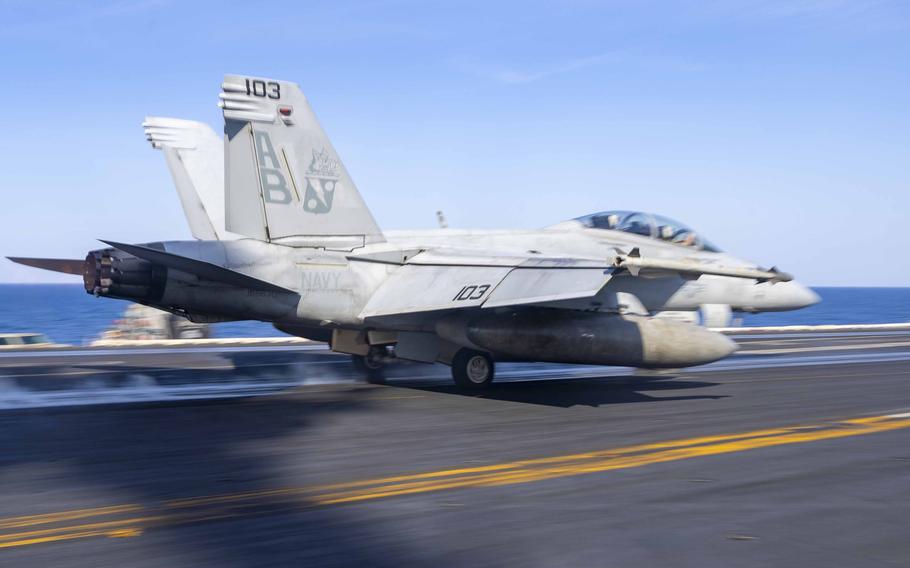
An F/A-18F Super Hornet, attached to Strike Fighter Squadron (VFA) 11, takes off from the flight deck of the Nimitz-class aircraft carrier USS Harry S. Truman on Dec. 16, 2024. (Logan McGuire/U.S. Navy)
NAPLES, Italy — Two Navy aviators were rescued after the fighter jet they were flying was shot down this week in an apparent “friendly fire” incident were responding to incoming one-way aerial attack drones and anti-ship cruise missiles threatening U.S. forces in the Red Sea, a defense official said Monday.
The service members had safely returned from a previous mission and had relaunched to provide air defense, the defense official said on condition of anonymity. The official was not authorized to speak publicly about the incident.
“They were shot down while recovery of remaining aircraft was underway,” said the official, who referred to the aviators as pilots.
In the hours leading up to the incident, the Truman Carrier Strike Group had successfully intercepted two anti-ship cruise missiles and two one-way aerial attack drones with reports of other unmanned vehicles in the air, the official added.
In a statement on Sunday, U.S. Central Command said the guided-missile cruiser USS Gettysburg, part of the Truman CSG, had mistakenly fired on and hit the F/A-18 Super Hornet as it was flying off the aircraft carrier USS Harry S. Truman.
Initial reports indicated that one of the aviators had suffered minor injuries, but both service members were aboard Truman on Monday and had been evaluated and released by medical staff, the official said.
It wasn’t clear how Gettysburg made the error, particularly since ships in a battle group remain linked by radar and radio communication. It also remained unknown what type of missile was used to shoot down the fighter jet or if the Navy is working to recover the aircraft.
An investigation is underway to determine the facts and circumstances, the official said.
In March, officials aboard the aircraft carrier USS Dwight D. Eisenhower, on duty in the Red Sea at the time, acknowledged Houthi fighters had been savvy in adapting their efforts with swarm drone attacks and upgraded ballistic missile capabilities.
The Middle East is a difficult tactical environment with significant surface and air traffic, and atmospheric conditions that can challenge communications, said James Holmes, chair of the maritime strategy program at the Naval War College in Newport, R.I.
“Add the stress of a combat situation and the sheer fog of war, and it is not farfetched to imagine a crew could mistake the identity of an aircraft and take it under fire,” Holmes said.
On Saturday, U.S. forces conducted airstrikes targeting a Houthi missile storage facility and a command hub in Yemen, CENTCOM said in a statement the same day.
During the mission, U.S. forces also shot down multiple Houthi one-way attack drones and an anti-ship cruise missile over the Red Sea. Air Force and Navy assets, including F/A-18s, were used in the operation, CENTCOM said.
A Houthi military spokesman released a statement on Sunday in which he claimed the rebels launched eight cruise missiles and 17 drones in an attack against U.S. forces. He also claimed without offering any evidence that the Houthis shot down the F/A-18, likely following a pattern of him making exaggerated claims, the Associated Press reported the same day.
Saturday’s mission against the Iranian-backed group was the second in the last week.
On Dec. 16, U.S. forces also targeted a Houthi militant facility that facilitated the group’s attacks against ships in the region. In November, a series of U.S. airstrikes against Houthi militants targeted weapons bunkers in Yemen. Those strikes included Air Force and Navy assets, such as F-35C stealth fighter jets.
The strikes come following the arrival of the Truman Carrier Strike Group in the Middle East a little more than a week ago.
The group includes the destroyers USS Stout and USS Jason Dunham, and Carrier Air Wing 1 with nine embarked aviation squadrons.
The Pentagon has beefed up its presence in the region with additional Air Force bombers, fighter jets and refueling aircraft.